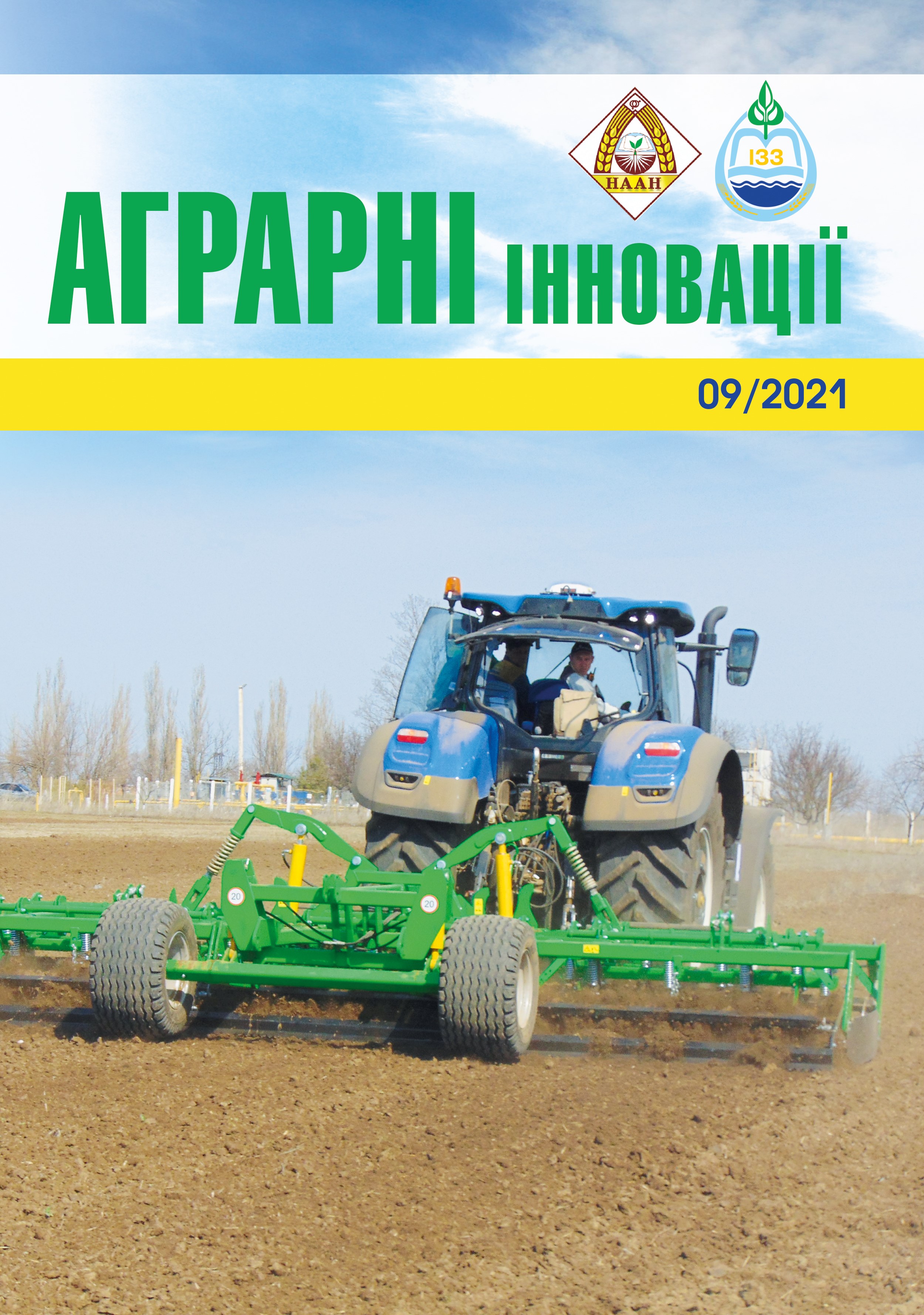Features of the formation of the hydrochemical regime of irrigation water of the Ingulets main canal in 2021
Abstract
Purpose. To Investigate the peculiarities of the formation of the hydrochemical regime of irrigation water of the Ingulets main canal in 2021 and assess the suitability of water for irrigation according to the current standards. Methods. Field experiment, laboratory analyses of water according to standard methods, systemic approach and systemic analysis, data generalization, comparison. Results. To assess the quality of irrigation water of the Ingulets main canal, a monitoring network of observations was established: a water sampling point at Picket 48 of the Ingulets main canal. During the study period, the mineralization of irrigation water of the Ingulets main canal ranged from 1550 mg / dm3 (as of June 26) to 750 mg / dm3 (on August 25). The average mineralization of irrigation water was 1215 mg / dm3. During the research period, the content of chlorides in irrigation water of the Ingulets main canal ranged from 367 mg / dm3 (as of June 26) to 193 mg / dm3 (as of June 26). The average value of chloride content in irrigation water during the study period was 263 mg / dm3. The decrease in the content of chlorides in irrigation water in August-September is explained by the fact that in the second half of August, due to favorable conditions along the Ingulets riverbed, the Dnieper water was drawn to the mouth of the Main pumping station by the "anti-river". But this situation does not happen every year, it is a special case. At the same time, for the formation of more or less satisfactory water quality with the use of "anti-river" technology requires constant round-the-clock operation of at least four Main pumping station units, but it will not provide constant stable satisfactory water quality, as evidenced by many years of research. The water quality assessment was performed according to the current normative documents, namely: the state standard of Ukraine “DSTU 2730: 2015. Environmental Protection. Quality of natural water for irrigation. Agronomic Criteria ”and the Resolution of the Cabinet of Ministers of Ukraine dated 02.09.2020 № 766 “On standards of ecologically safe irrigation, drainage, irrigation and drainage management”. Conclusions. According to the danger of irrigation salinization of the soil according to DSTU 2730: 2015. – Class I water (suitable for irrigation without restrictions) for medium loam and heavy loam soils; Class II and I for clay soils. According to Resolution № 766 – irrigation is safe, but taking into account the II Class of quality according to agronomic criteria – irrigation is possible provided that of remedial measures are applied. According to the danger of soil alkalinization, according to DSTU 2730: 2015 – water belongs to the Class I, according to the Resolution of the Cabinet of Ministers of Ukraine № 766 – irrigation is safe. According to the danger of soil salinization – according to DSTU 2730: 2015 – Class I water for dark chestnut and chestnut loam medium- and high-buffer soils and for chernozem loam soils medium- and high-buffer. For chernozem clay soils of medium and high buffer – in June – water of the Class III, ie water is unsuitable for irrigation without preliminary improvement of its composition; in July and early August – class II water, from mid-August and in September – class I water. According to Resolution № 766: in June – watering is prohibited, in July and early August – irrigation is possible provided the remedial measures are applied, from mid-August and in September – watering is safe. According to the danger of toxic effects of water on plants according to DSTU 2730: 2015 – water of the Class II, according to the Resolution of the Cabinet of Ministers № 766 – irrigation is possible provided that application of restorative measures are applied.
References
2. Ткачук В.Г. и др. Изменение мелиоративно-гидрогеологических условий водораздельных массивов под влиянием орошения: монография. Киев: Урожай, 1970. 248 с.
3. Землі Інгулецької зрошувальної системи: стан та ефективне використання / За наук. ред. В.О. Ушкаренка, Р.А. Вожегової. Київ: Аграр. наука, 2010. 352 с.
4. Морозов В.В., Козленко Є.В. Інгулецька зрошувальна система: покращення якості поливної води: монографія. Херсон: ПП «ЛТ-Офіс», 2015. 210 с.
5. Козленко Є.В., Морозов О.В., Морозов В.В. Новий варіант технології формування якості води Інгулецької зрошувальної системи при відновленні проектної площі зрошення. Таврійський науковий вісник. Сільськогосподарські науки. Херсон, 2021. № 119. С. 43-51.
6. Морозов В.В., Нежлукченко В.М., Волочнюк Є.Г. Формування якості зрошувальної води на Інгулецькому масиві. Херсон: Колос, 2004. 228 с.
7. Козленко Є.В., Морозов О.В., Морозов В.В. Інгулецька зрошувальна система: стан, проблеми та перспективи розвитку: монографія. За ред. О.В. Морозова. Херсон: Айлант, 2020. 204 с.
8. Коваленко Р.Ю., Ковальчук П.І. Аналіз методів управління якістю води для зрошення при промивках русла р. Інгулець дніпровською водою. Індуктивне моделювання складних систем. Київ, 2014. Випуск 6. С. 90-96.
9. Хільчевський В.К., Кравчинський Р.Л., Чунарьов О.В. Гідрохімічний режим та якість води Інгульця в умовах техногенезу. Київ: Ніка-Центр, 2012. 180 с.
10. Морозов О.В., Морозов В.В., Козленко Є.В., Біднина І.О. Оцінка якості зрошувальної води в системі еколого-меліоративного моніторингу. Водні біоресурси та аквакультура. Сільськогосподарські науки. 2020. № 2. С. 192-209.
11. ДСТУ 2730:2015. Захист довкілля. Якість природної води для зрошення. Агрономічні критерії. Вид. офіц. Київ: Мінекономрозвитку України, 2015. 9 с.
12. Про нормативи екологічно безпечного зрошення, осушення, управління поливами та водовідведенням: Постанова Кабінету Міністрів України від 02.09.2020 р. № 766. Офіційний вісник України. 2020. № 73. С. 27-31.






